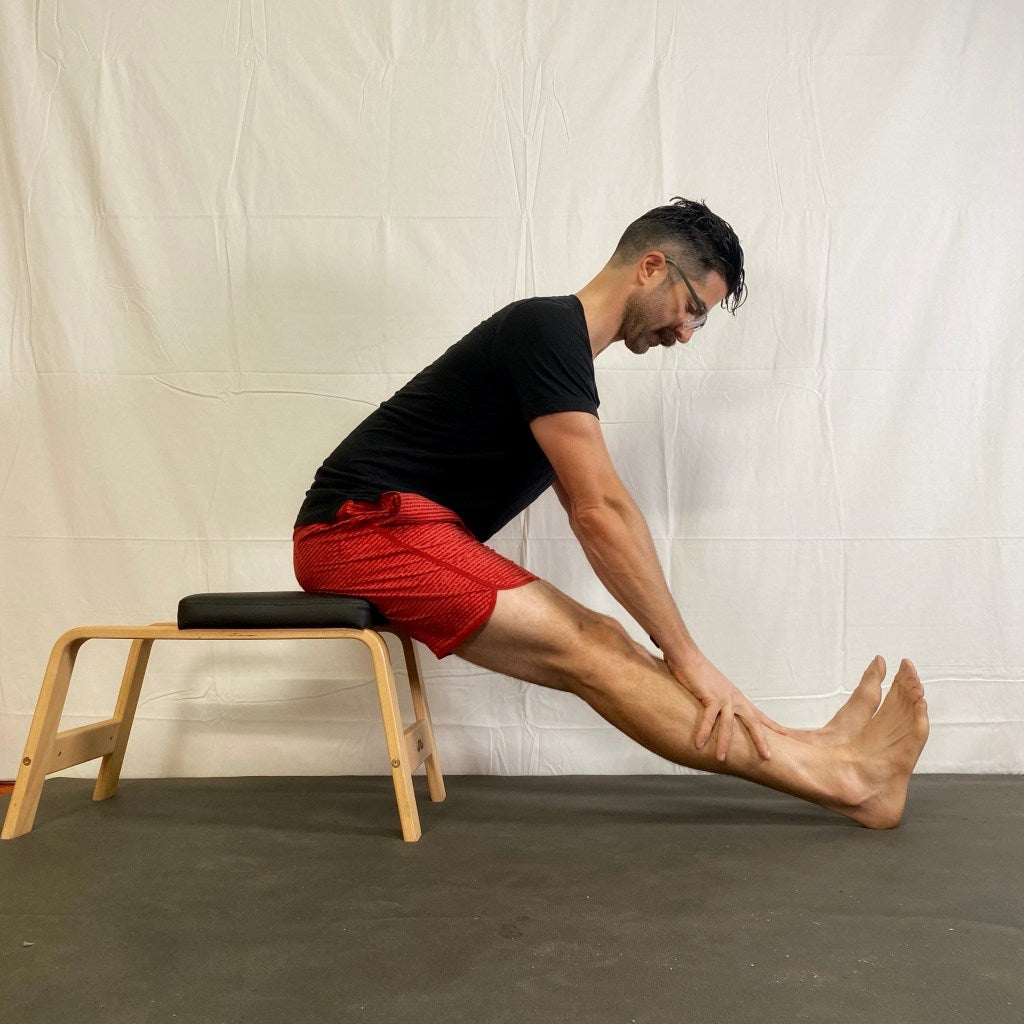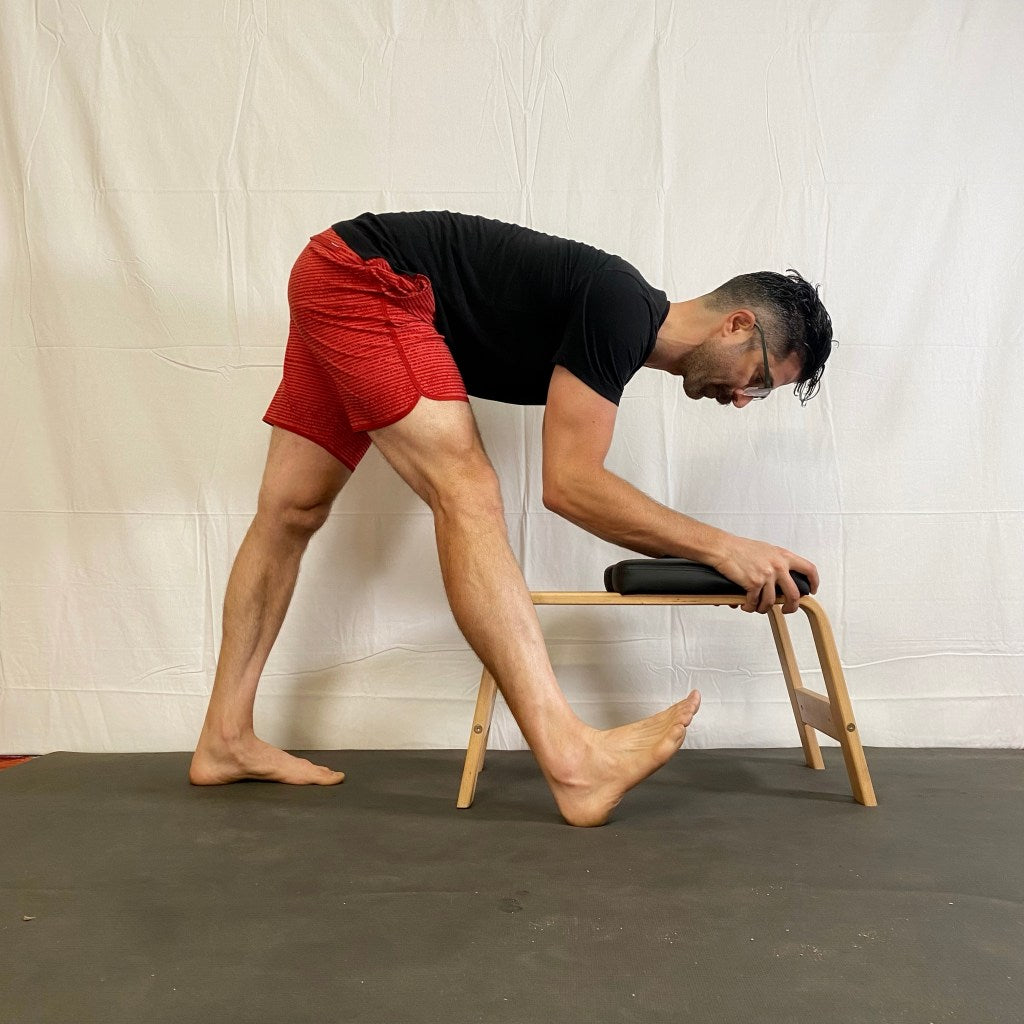Even though forward folds look simple, they can be surprisingly challenging.
Here are five great poses to help build the flexibility (and patience) needed to deepen your forward folds practice with your FeetUp Trainer.
Seated Forward Folds (Paschimottanasana)
 This calming pose stimulates the internal organs while stretching the legs and back body. Areas of Focus: spine, upper back (shoulder blades), lower back, hips, hamstrings, calves. How to use your FeetUp Trainer to deepen the pose:
This calming pose stimulates the internal organs while stretching the legs and back body. Areas of Focus: spine, upper back (shoulder blades), lower back, hips, hamstrings, calves. How to use your FeetUp Trainer to deepen the pose:
- The extra height provides more leverage to lengthen hamstrings without having to fold as much.
- Use this to focus on maintaining a long spine without rounding the upper shoulders or neck.
- Keep the knees unlocked (locked = fully extended) for less resistance in the hamstrings and calves.
- Try tucking the edge of the cushion just under the sit bones for extra length and stretch.
Supported Half Split / Runner's Lunge (Supported Ardha Hanumanasana)
 This helpful pose teaches patience and releases tension in your lower body, one leg at a time.
This helpful pose teaches patience and releases tension in your lower body, one leg at a time.
Areas of Focus: Back body (spine, upper & lower back), Legs (thighs, hamstrings, calves), Hips, Groins
How to use your FeetUp Trainer to deepen the pose:
- You don't have to reach as far to feel grounded. The extra height brings the floor "closer" to your torso!
- Use the cushion for more support! Start on your hands with extended arms and work down to your forearms as your body opens up.
- Gently hug the inside of the extended thigh / calf to the outside edge of the frame to maintain length.
- Square the line between your hip bones off with the front edge of the cushion.
- The frame easily holds your entire bodyweight. Don't be afraid to release fully once you feel supported!
Seated Single Leg Forward Folds (Elevated Marichyasana)
 This single leg forward fold pose found in the Ashtanga primary series invites practitioners to bind their arms during a forward fold. The FeetUp Trainer offers some great alternatives to deepen the pose without having to do that!
This single leg forward fold pose found in the Ashtanga primary series invites practitioners to bind their arms during a forward fold. The FeetUp Trainer offers some great alternatives to deepen the pose without having to do that!
Areas of Focus: spinal flexibility, shoulders, hips, legs, lower back.
How to use your FeetUp Trainer to deepen the pose:
- Press fully through the foot of the bent leg to maintain stability in the pelvis.
- Keep the knee directly above the heel, even if you have to step the foot out wider to the side to find a comfortable position.
- Start with hands on bent knee and opposite thigh as you work begin folding torso forward over extended leg.
- Extra height provides more space for your torso to fold forward with your hips grounded without rounding the spine.
- Don't forget to breathe... especially if you're able to fold the torso to the inside of the bent knee!
Standing Pyramid Pose (Supported Parsvottonasana)
 Build strength while increasing flexibility and body awareness with this dynamic standing forward fold posture.
Build strength while increasing flexibility and body awareness with this dynamic standing forward fold posture.
Areas of Focus: hamstrings, calves, ankles, back body, hips
How to use your FeetUp Trainer to deepen the pose:
- Use the frame for extra support! You don't have to reach down as far to connect with the ground.
- Focus on maintaining a long spine and neutral neck.
- Square the line between your hip bones off with the front edge of the cushion for better alignment.
- Start on fingertips with arms extended before lowering to palms and bending elbows.
- Start with gaze just over the far edge of the trainer, releasing head and neck last once you find the deepest expression of forward fold available.
- Flex ankle of the extended leg for a deeper hamstring stretch!
Standing Wide Leg Forward Folds (Supported Prasarita Padottanasana)
 This simple pose gently opens the insides of the legs while elongating the back and side bodies.
This simple pose gently opens the insides of the legs while elongating the back and side bodies.
Areas of Focus: hips, spine, shoulders, ankles, lower back
How to use your FeetUp Trainer to deepen the pose:
- Use the frame to counteract the natural tendency of the shoulders to shrug down towards the ears as you fold forward.
- Instead of reaching down to the floor, extend through the Trainer to to keep the arms engaged, collarbones broad, and legs active.
- Unlock the knees (tiny micro-bend) to avoid over-stretched hamstrings and over-extended legs.
- Start on fingertips with arms extended before lowering to palms and bending elbows.









